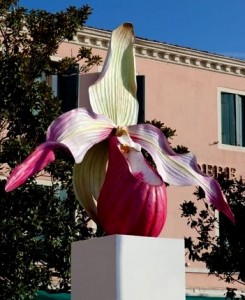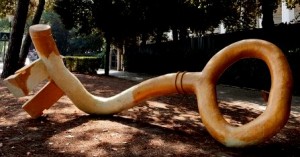Exhibition Reviews
| Home | | Museum Guide | | International | | Theater |
The Flowering of Art on the Lido di Venezia
By Edward Rubin.
OPEN 14
International Exhibition of Sculptures and Installations
September 1 – October 2, 2011
 |
Marc
Quinn (England), The Chromatic Archaeology of Desire (2008) Painted
Bronze. Photo: Sergio Martucci |
Each year, OPEN, one of the most entertaining art exhibitions in the art
world, peppers the beautiful island of Lido with unexpected and imaginative
sculptures and installations. Essentially an outdoor walking tour with a few
in-hotel installations, OPEN begins the minute you disembark from the vaporetto
onto the Piazzale St. Maria Elisabetta. It continues along the shop and restaurant
laden Via Lepanto, morphs into the lushly planted promenade of Lungomare G.
Marconi, and ends overlooking the beach, at the very chic Hotel Westin Excelsior,
the infamous hangout of the Venice Film Festival crowd. This year Madonna
and George Clooney, followed by lusting hordes of screaming acolytes, was
all the rage.
Founded by Paolo De Grandis fourteen years ago, and cleverly scheduled to
run alongside the Venice Film Festival, as well as to overlap in its exhibition
dates with the Venice Art and Architectural Biennales; the exhibition plays
host to thousands in its month long run. What makes OPEN exceptional, in addition
to its heady location and its ‘built in audience’ of highly cultured
attendees – both which add more then a dollop of frisson to the viewing
experience – is chief curator De Grandis’s highly eclectic and
freewheeling taste. Banishing the very notion of a themed exhibition he relies
solely on the intelligence and beauty of each work, and the unique and surprising
placement among the island’s flora, fauna, and beautifully designed
hotels, to capture our attention.
This year, OPEN 14, co-curated by Carlotta Scarpa, Ebadur Rahman, Nevia Capello, Christos Savvidis, and Gloria Vallese, who also curated, along with Wang Lin, the highly touted Cracked Culture? The Quest for Identity in Contemporary Chinese Art, a Venice Biennale Collateral Event, featured twenty-eight artists from Albania, Bangladesh, China, England, Finland, Germany, Greece, Iran, Italy, Romania, and Switzerland.
 |
| Feng Feng (China), W Fountain 2010 installation. Photo: Courtesy Arte Communications |
The first work seen, even before the boat docks, is The Chromatic Archaeology of Desire (2008), London based artist Mark Quinn’s super realistic painted orchid. Perched atop a tall pedestal, it is an elegant poem in bronze that speaks to the beauty and fragility of everyday life. Down the road, housed in a small, multi-level vitrine on wheels, are 3000 of Romanian artist Martin-Emilian Balint’s laminated cardboard figures. Titled Embrace (2011), the marching figures, standing shoulder to shoulder, seem to offer an expression of love while welcoming visitors to the island. Across the street, echoing similar sentiments is Applauses (2007), a tall metal vase covered with hundreds of ceramic-crafted open hands. Created by Italian artist Tarshito, the vase, significantly placed at the entrance to the Grande Albergo Ausonia & Hungaria Hotel, where it appeared to be applauding the arrival of its guests.
Several show-stopping and intellectually-challenging works welcomed viewers to the Lungomare G. Marconi, the section of the exhibition most arrayed with art. In city terms, this part of the exhibition runs some 5 or 6 city blocks. First to catch our eye, and especially hypnotic, when lit up at night, was Chinese artist Feng Feng’s stunning W Fountain (2010), an intensely bright yellow McDonald’s sign, the iconic form turned upside down. Also prominently featured in Vallese’s Cracked Culture exhibition, W Fountain is the artist’s comment on the rampant spread of Western culture—in this case, fast food. Some ten feet away, separated by a tree and some foliage– as were most of the works along this botanical stretch–was "Hey?!!" Italian artist Filippo Zuriato’s terracotta sculpture of a young Chinese boy enclosed in a wire cage. Dressed in the ubiquitous T-shirt and jeans outfit–the boy points to his almond shaped eyes. The work, in which the boy boldly calls attention to himself, was open to a myriad of interpretations: possible loss of identity is one; loss of freedom, another.
 |
| Filippo Zuriato (Italy), "Hey?!!" (2011), painted terracotta. Photo by Sergio Martucci. |
. Across the avenue, enticingly situated at the entrance to
the beach, was Bangladesh artist Ronni Ahmmed’s intricately constructed
sculpture, The Tomb of Qara Köz (2011). Rooted in Opera Aperta, or ‘open
work of art,’ as set forth by Umberto Eco’s book of the same name,
and traditional Bengali theatre (both of which use history to tell their stories),
Tomb was composed of three layers of 1254 glasses, each holding a cartoon-painted
egg in the manner of Bassano, Veronese, and Tintoretto. The pyramidal sculpture,
top-heavy in meaning, was meant to recall, as the catalog informed us, the
campaign of Mughal princess Qara Köz, who exerted powerful influence
in the Florence of Medici. The sculpture’s three planes paid homage
to Venice’s Bengali immigrants, the adventures of Pinocchio, and Fairytale,
Ai Weiwei’s 2007 Documenta installation, the latter which inspired Ahmmed
to emulate Weiwei and invite 101 Bengalis visitors to his tomb, to record
their secret desires, pay alms, and make their wishes come true.
Back to the residential side of Lungomare G. Marconi – which is lined
with a steady stream of stately mansions – could be seen Albanian artist,
Alfred Milot Mirashi’s Do, Try (2011), a large, severely bent, partially-painted
golden key, reminiscent of Oldenburg’s sculptures of everyday objects.
Though minimally constructed, it maximized the ideas it conjured, as everybody,
the world over, not only deals with keys but uses the very word in many contexts.
The ‘key to my heart’ comes quickly to mind, followed by the ‘key
to the city’, among other things. Though these are popular usages, according
to curator Rahman, Mirashi is thinking about the human body— the twisted,
tormented people "who reach out, body and soul, in their yearning for
peace." Given the key’s contorted anatomical referencing, it seems
the artist’s wish for universal peace will be a long-time coming.
 |
| Alfred Milot Mirashi (Albania), Do, Try (2011) - iron, aluminium, glue, plaster, jute, foam, gold paint, fibre glass. Photo: Sergio Martucci |
Italian artist Marina Gavazzi set her incendiary sights on the hypocrisy of the Catholic Church, in her four-sided installation, His Holiness (2011), particularly the shameful attempt by the highest echelons of the Vatican to cover up sex crimes against minors by priests, especially in the United States. Digital prints of the Pope, printed on plastic panels, showed The Holy See engulfed in flames. Presumably in hell, he is facing punishment for centuries of violence committed by the church, in the name of their creed, against the people. The cited the Inquisition in her catalog essay, all of the countries– both past and present –complicit with the Vatican’s actions, remained unnamed. Perhaps there are just too many to list, especially in such proximity to the Vatican.
The conceptual work of Puni and Marilena Vita, two Italian artists, added a bit of levity to the exhibition. Openings (2011), Puni’s installation comprised a common door, set upright on a patch of green grass. Like Mirashi’s key, Do,Try, serves as an everyday object and a universal symbol; like the key and its many interpretations, the viewer is encouraged to make of it what we would. Our first thought, given the door’s bucolic setting, was one of freedom, entering a new world. On closer examination the words ‘Emergency Exit’ appeared on the door, exposing the other side of the coin, alerting us to the ever-present possibility of imminent danger. Also playing with our minds, as well as our eyes, is Marilena Vita’s Legs (2011), a compelling, surreal photograph, printed on vinyl, of the artist’s long legs. One set of legs is real, the other, reflected in a mirror and appearing in reverse, seems to be growing out of the first set of legs. With our perspective disoriented, our eyes work overtime to make sense of what we are looking at.
I ended my tour of OPEN 14–which began with an orchid,
and finished in the lobby of the Excelsior– just in time for a cocktail
at the hotel’s renowned Blue Bar I might add – as I stood mesmerized
in front of another floral work, Fiori (2011), an astonishingly beautiful
painting of peonies by Milan based artists, Sandra Casagrande and Roberto
Recalcati. Melding a color palette of luxurious creams and pinks, evoking
the voluptuous imagery of French Rocco painters Jean Honoré Fragonard
and Francois Boucher, together with the kind of lingering Hollywood close-ups
that forever etched Garbo’s face in our collective memory—the
artists have rendered a cinematically-exquisite floral motif in paint, whose
silky petals actually appear to be opening in slow-motion. It is here, imaginatively
savoring the heady aroma of the perfumed bouquet, where we get to experience
the magic of art in all its multi-sensory glory.
Edward Rubin is a writer and critic living in New York City. His articles and reviews have appeared in ARTnews, New Art Examiner, www.manhattanarts.com, Hispanic Outlook, www.nytheatre-wire.com and Theatre Week. He can be reached at erubin5000@aol.com.